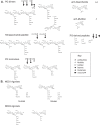Peptidoglycan fragment release and NOD activation by commensal Neisseria species from humans and other animals
- PMID: 38563734
- PMCID: PMC11075463
- DOI: 10.1128/iai.00004-24
Peptidoglycan fragment release and NOD activation by commensal Neisseria species from humans and other animals
Abstract
Neisseria gonorrhoeae, a human restricted pathogen, releases inflammatory peptidoglycan (PG) fragments that contribute to the pathophysiology of pelvic inflammatory disease. The genus Neisseria is also home to multiple species of human- or animal-associated Neisseria that form part of the normal microbiota. Here we characterized PG release from the human-associated nonpathogenic species Neisseria lactamica and Neisseria mucosa and animal-associated Neisseria from macaques and wild mice. An N. mucosa strain and an N. lactamica strain were found to release limited amounts of the proinflammatory monomeric PG fragments. However, a single amino acid difference in the PG fragment permease AmpG resulted in increased PG fragment release in a second N. lactamica strain examined. Neisseria isolated from macaques also showed substantial release of PG monomers. The mouse colonizer Neisseria musculi exhibited PG fragment release similar to that seen in N. gonorrhoeae with PG monomers being the predominant fragments released. All the human-associated species were able to stimulate NOD1 and NOD2 responses. N. musculi was a poor inducer of mouse NOD1, but ldcA mutation increased this response. The ability to genetically manipulate N. musculi and examine effects of different PG fragments or differing amounts of PG fragments during mouse colonization will lead to a better understanding of the roles of PG in Neisseria infections. Overall, we found that only some nonpathogenic Neisseria have diminished release of proinflammatory PG fragments, and there are differences even within a species as to types and amounts of PG fragments released.
Keywords: NOD1; NOD2; Neisseria; ampG; immune response; inflammation; ldcA; peptidoglycan.
Conflict of interest statement
The authors declare no conflict of interest.
Figures










Similar articles
-
Neisseria gonorrhoeae Crippled Its Peptidoglycan Fragment Permease To Facilitate Toxic Peptidoglycan Monomer Release.J Bacteriol. 2016 Oct 7;198(21):3029-3040. doi: 10.1128/JB.00437-16. Print 2016 Nov 1. J Bacteriol. 2016. PMID: 27551020 Free PMC article.
-
A Single Dual-Function Enzyme Controls the Production of Inflammatory NOD Agonist Peptidoglycan Fragments by Neisseria gonorrhoeae.mBio. 2017 Oct 17;8(5):e01464-17. doi: 10.1128/mBio.01464-17. mBio. 2017. PMID: 29042497 Free PMC article.
-
Peptidoglycan fragment release from Neisseria meningitidis.Infect Immun. 2013 Sep;81(9):3490-8. doi: 10.1128/IAI.00279-13. Epub 2013 Jul 8. Infect Immun. 2013. PMID: 23836824 Free PMC article.
-
Attention Seeker: Production, Modification, and Release of Inflammatory Peptidoglycan Fragments in Neisseria Species.J Bacteriol. 2017 Sep 19;199(20):e00354-17. doi: 10.1128/JB.00354-17. Print 2017 Oct 15. J Bacteriol. 2017. PMID: 28674065 Free PMC article. Review.
-
The Pathogenic Neisseria Use a Streamlined Set of Peptidoglycan Degradation Proteins for Peptidoglycan Remodeling, Recycling, and Toxic Fragment Release.Front Microbiol. 2019 Jan 31;10:73. doi: 10.3389/fmicb.2019.00073. eCollection 2019. Front Microbiol. 2019. PMID: 30766523 Free PMC article. Review.
Cited by
-
Genetic Manipulation of Neisseria gonorrhoeae and Commensal Neisseria Species.Curr Protoc. 2024 Sep;4(9):e70000. doi: 10.1002/cpz1.70000. Curr Protoc. 2024. PMID: 39228292 Free PMC article.
-
Bacterial and host enzymes modulate the pro-inflammatory response elicited by the peptidoglycan of Lyme disease agent Borrelia burgdorferi.PLoS Pathog. 2025 Jul 7;21(7):e1013324. doi: 10.1371/journal.ppat.1013324. eCollection 2025 Jul. PLoS Pathog. 2025. PMID: 40623106 Free PMC article.
-
Bacterial and host enzymes modulate the inflammatory response produced by the peptidoglycan of the Lyme disease agent.bioRxiv [Preprint]. 2025 May 31:2025.01.08.631998. doi: 10.1101/2025.01.08.631998. bioRxiv. 2025. Update in: PLoS Pathog. 2025 Jul 7;21(7):e1013324. doi: 10.1371/journal.ppat.1013324. PMID: 39829805 Free PMC article. Updated. Preprint.
-
Commensal bacterial glycosylation at the interface of host-bacteria interactions.Gut Microbes. 2025 Dec;17(1):2545421. doi: 10.1080/19490976.2025.2545421. Epub 2025 Aug 14. Gut Microbes. 2025. PMID: 40810484 Free PMC article. Review.
-
The hidden base of the iceberg: gut peptidoglycome dynamics is foundational to its influence on the host.Gut Microbes. 2024 Jan-Dec;16(1):2395099. doi: 10.1080/19490976.2024.2395099. Epub 2024 Sep 6. Gut Microbes. 2024. PMID: 39239828 Free PMC article. Review.
References
-
- Burcham ZM, Garneau NL, Comstock SS, Tucker RM, Knight R, Metcalf JL, Taste Lab Citizen S, Genetics of Taste Lab Citizen Scientists . 2020. Patterns of oral microbiota diversity in adults and children: a crowdsourced population study. Sci Rep 10:2133. doi:10.1038/s41598-020-59016-0 - DOI - PMC - PubMed
Publication types
MeSH terms
Substances
Grants and funding
LinkOut - more resources
Full Text Sources
Molecular Biology Databases

